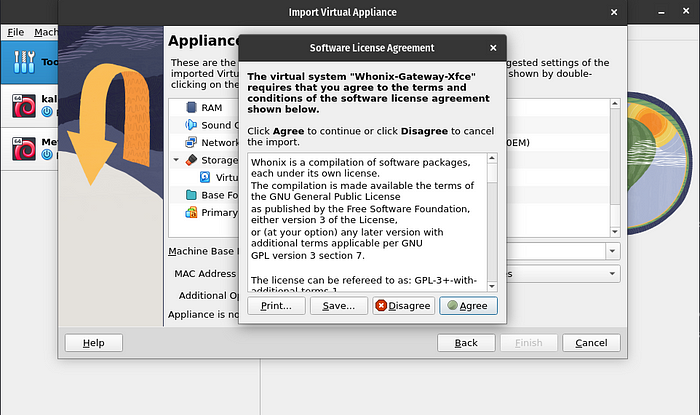Remaining Anonymous: Getting Started with Whonix

Whonix is a free and open-source operating system focused on enhancing privacy and security, built on the Debian distribution. It is designed to run inside a virtual machine, where it routes all internet traffic through the Tor network to protect the user's identity and online activities from surveillance and tracking. Whonix employs a unique architecture consisting of two virtual machines: the Gateway and the Workstation. The Gateway acts as a Tor proxy, ensuring that all network traffic from the Workstation is routed through the Tor network. This separation helps prevent IP address leaks and significantly boosts the user's anonymity.
In addition to its Tor-based architecture, Whonix includes a variety of privacy and security features, such as pre-configured firewalls, privacy-enhanced web browsers, and encrypted communication tools. It can be used as a standalone operating system or as an additional layer of security on top of an existing OS. By creating a barrier between the user and potential adversaries, Whonix offers a comprehensive solution for protecting online privacy and security.
Anonymity Features
Whonix’s anonymity architecture operates through a sophisticated combination of network isolation, protocol enforcement, and identity protection mechanisms. At its core, the system employs a dual virtual machine structure that physically separates the Tor routing mechanism from the user’s computing environment.

The Gateway VM serves as the cornerstone of anonymity enforcement. It captures all network traffic and forcibly routes it through the Tor network using a comprehensive set of iptables rules. These rules prevent any direct connection to the clearnet, effectively eliminating the possibility of IP address leakage. The Gateway implements strict DNS controls, routing all domain name resolution through Tor’s SOCKS proxy to prevent DNS-based deanonymization attacks.
Stream isolation represents a critical security feature within the Whonix architecture. When applications establish connections, the Gateway assigns them to separate Tor circuits. This isolation prevents correlation attacks that could otherwise link different activities to the same user. For instance, web browsing sessions remain isolated from email communications, and distinct browser profiles operate on independent circuits.
The Workstation VM operates in complete network isolation, with no knowledge of the host’s true IP address or network configuration. All applications within the Workstation inherit this isolation, making it impossible for malware or compromised software to reveal the user’s real location. The system implements time synchronization through the Tor network to prevent timestamp-based correlation attacks.
Memory management in Whonix incorporates multiple layers of protection. Address Space Layout Randomization (ASLR) prevents memory exploitation attacks, while kernel page-table isolation protects against side-channel attacks. The system can operate in a RAM-only configuration, leaving no persistent traces on storage media.
Network protocol enforcement extends beyond basic routing. The Gateway implements sophisticated traffic shaping to minimize the effectiveness of timing analysis attacks. It manages TCP window sizes and packet timing to reduce the network fingerprint. Custom bridge implementation allows users to access Tor in restricted environments while maintaining anonymity.
The system’s security model addresses advanced threats through multiple mechanisms. Mandatory Access Control restricts application privileges and enforces security policies at the kernel level. The filesystem can employ LUKS encryption with XTS-AES-512, protecting data at rest. Memory allocation includes guard pages and stack protection to prevent buffer overflow attacks.
The anonymity features extend to application-level protections. The browser environment includes advanced fingerprinting resistance, preventing websites from identifying users through system characteristics. JavaScript execution occurs in isolated contexts, preventing script-based deanonymization attempts.
Whonix VS Tails OS
Whonix and Tails are both privacy-focused operating systems that use the Tor network for anonymity, but they differ in design and use cases.
Whonix utilizes a two-virtual machine setup: the Gateway routes all traffic through Tor, and the Workstation handles user activities. This setup ensures strong isolation and is used persistently, maintaining configurations between sessions. It’s ideal for long-term use in secure environments, such as by researchers or journalists dealing with sensitive data.
Tails, on the other hand, is a live, amnesic operating system run from a USB or DVD. It leaves no trace on the host machine after shutdown, making it perfect for portable use where complete anonymity is required, such as for activists or whistleblowers. Tails doesn’t retain data unless saved in encrypted storage.
Whonix is better for persistent use where long-term privacy is essential, offering strong anonymity and security. Tails is suited for temporary use with minimal setup and complete erasure of activity, though its anonymity isn’t as robust as Whonix’s. The choice depends on whether you need persistent protection or a quick, anonymous solution.
Whonix OS Limitations and Drawbacks
- Performance Impact. Network performance suffers significantly due to Tor routing overhead. The dual-VM architecture consumes substantial system resources, requiring minimum 4GB RAM and causing noticeable CPU overhead.
- Technical Constraints. System complexity introduces multiple failure points. The reliance on virtualization technology creates additional attack surfaces through potential VM escape vulnerabilities. Time synchronization issues can arise due to Tor network latency, potentially affecting timestamp-dependent applications.
- Usability Challenges. The learning curve proves steep for non-technical users.
- Network Limitations. Many services actively block Tor exit nodes, severely limiting accessible content. Real-time applications (video calls, gaming) become impractical due to high latency.
How To Install Whonix
- Download the virtual machine image. There are two options for downloading: Xfce GUI or CLI. For demonstration purposes, I will use the graphical interface.

2. Import Whonix VMs into VirtualBox.

3. Agree with a software license.

4. Start Whonix-Gateway. Follow the prompts to set up Whonix-Gateway. This involves configuring network settings and connecting to the Tor network.

5. Start Whonix-Workstation. Follow the prompts to configure the Workstation, ensuring it connects through the Whonix-Gateway.

Summary
Whonix is a valuable tool for those seeking enhanced anonymity and security in their digital lives. It has the potential to transform your online experience for communication, browsing and working.
Subscribe to our newsletter to receive exclusive privacy/anonymity tips and insights.

